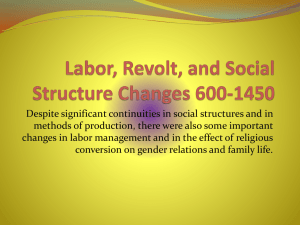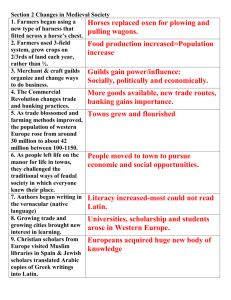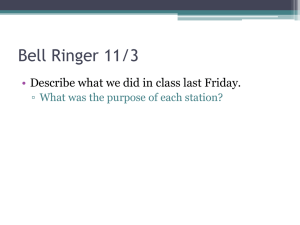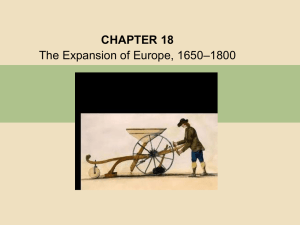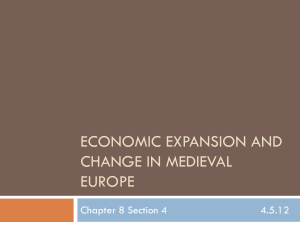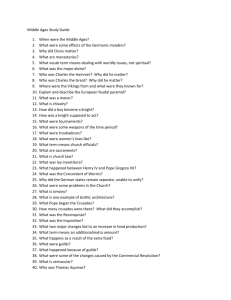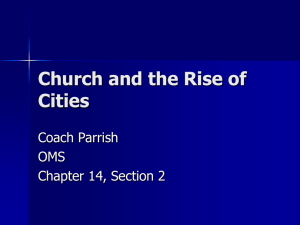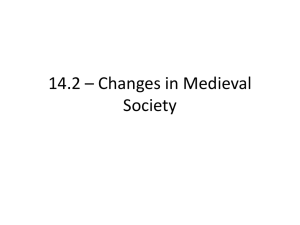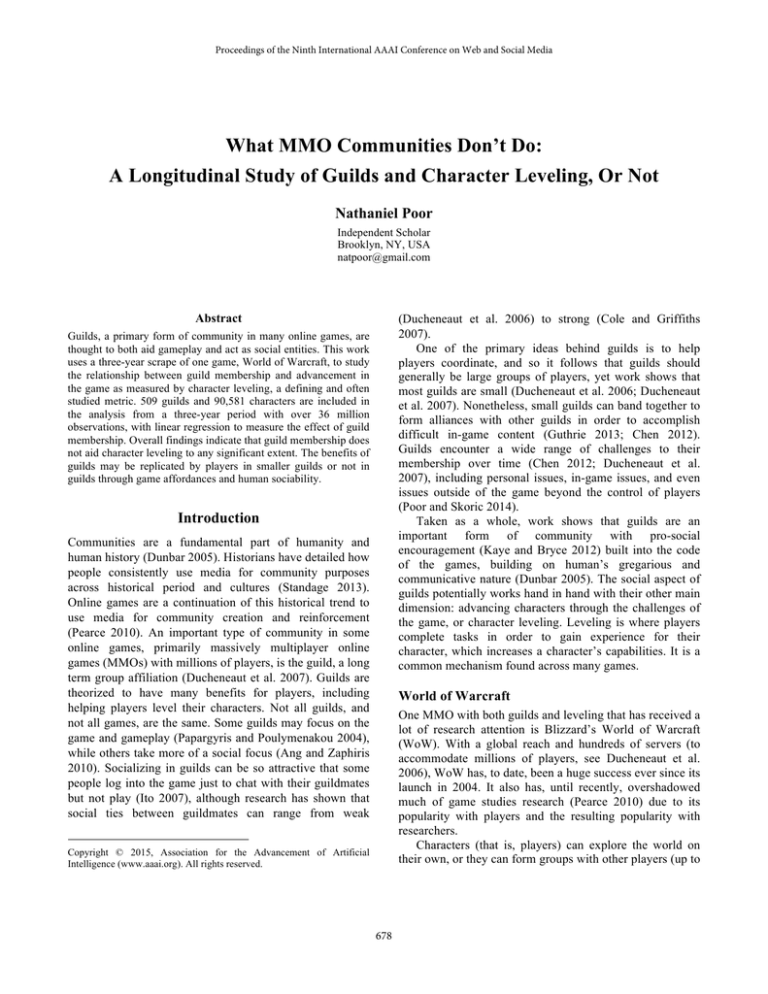
Proceedings of the Ninth International AAAI Conference on Web and Social Media
What MMO Communities Don’t Do:
A Longitudinal Study of Guilds and Character Leveling, Or Not
Nathaniel Poor
Independent Scholar
Brooklyn, NY, USA
natpoor@gmail.com
Abstract
(Ducheneaut et al. 2006) to strong (Cole and Griffiths
2007).
One of the primary ideas behind guilds is to help
players coordinate, and so it follows that guilds should
generally be large groups of players, yet work shows that
most guilds are small (Ducheneaut et al. 2006; Ducheneaut
et al. 2007). Nonetheless, small guilds can band together to
form alliances with other guilds in order to accomplish
difficult in-game content (Guthrie 2013; Chen 2012).
Guilds encounter a wide range of challenges to their
membership over time (Chen 2012; Ducheneaut et al.
2007), including personal issues, in-game issues, and even
issues outside of the game beyond the control of players
(Poor and Skoric 2014).
Taken as a whole, work shows that guilds are an
important form of community with pro-social
encouragement (Kaye and Bryce 2012) built into the code
of the games, building on human’s gregarious and
communicative nature (Dunbar 2005). The social aspect of
guilds potentially works hand in hand with their other main
dimension: advancing characters through the challenges of
the game, or character leveling. Leveling is where players
complete tasks in order to gain experience for their
character, which increases a character’s capabilities. It is a
common mechanism found across many games.
Guilds, a primary form of community in many online games, are
thought to both aid gameplay and act as social entities. This work
uses a three-year scrape of one game, World of Warcraft, to study
the relationship between guild membership and advancement in
the game as measured by character leveling, a defining and often
studied metric. 509 guilds and 90,581 characters are included in
the analysis from a three-year period with over 36 million
observations, with linear regression to measure the effect of guild
membership. Overall findings indicate that guild membership does
not aid character leveling to any significant extent. The benefits of
guilds may be replicated by players in smaller guilds or not in
guilds through game affordances and human sociability.
Introduction
Communities are a fundamental part of humanity and
human history (Dunbar 2005). Historians have detailed how
people consistently use media for community purposes
across historical period and cultures (Standage 2013).
Online games are a continuation of this historical trend to
use media for community creation and reinforcement
(Pearce 2010). An important type of community in some
online games, primarily massively multiplayer online
games (MMOs) with millions of players, is the guild, a long
term group affiliation (Ducheneaut et al. 2007). Guilds are
theorized to have many benefits for players, including
helping players level their characters. Not all guilds, and
not all games, are the same. Some guilds may focus on the
game and gameplay (Papargyris and Poulymenakou 2004),
while others take more of a social focus (Ang and Zaphiris
2010). Socializing in guilds can be so attractive that some
people log into the game just to chat with their guildmates
but not play (Ito 2007), although research has shown that
social ties between guildmates can range from weak
World of Warcraft
One MMO with both guilds and leveling that has received a
lot of research attention is Blizzard’s World of Warcraft
(WoW). With a global reach and hundreds of servers (to
accommodate millions of players, see Ducheneaut et al.
2006), WoW has, to date, been a huge success ever since its
launch in 2004. It also has, until recently, overshadowed
much of game studies research (Pearce 2010) due to its
popularity with players and the resulting popularity with
researchers.
Characters (that is, players) can explore the world on
their own, or they can form groups with other players (up to
Copyright © 2015, Association for the Advancement of Artificial
Intelligence (www.aaai.org). All rights reserved.
678
five in WoW). MMOs generally include code to assist in
and reify groups. Players are invited to a group, and the
game recognizes that they are together in terms of their
interaction with each other and the game world. Generally
speaking, together in groups players can take on monsters
that are too powerful to take on alone. The extension of
groups is the raid, that is, several groups working together.
Both groups and raids are temporary associations.
Guilds, on the other hand, are typically longer-term
associations with other characters (and thus players). Guilds
can give players easy and trusted connections to other
players. It is the potential for long-term association through
guilds that is theorized to build trust between players.
Guilds have names and can be part of a character’s, and
player’s, identity. Many guilds are actually quite small—
too small to form a group (Ducheneaut et al. 2007; Poor
2014), let alone a larger raid force, leading to alliances
between players and guilds (Poor 2014). Guilds face certain
social stresses (Chen 2012), and collaboration between
guild members is important for gameplay and socialization
(Chen 2009).
Work has shown, surprisingly, how characters that
spend more time in groups actually advance in level more
slowly than those who spend less time grouped
(Ducheneaut et al. 2006). This is initially counter-intuitive,
as groups allow players to conquer tougher challenges that
give more experience. Yet this could be because those who
play solo never have to wait for their other group members,
either in terms of finding players to group with or during
gameplay if a player needs to respond to something in the
real world such as the phone, needs of a child, food, or a
bathroom break.
With this work in mind, and with the available data, we
can ask if belonging to a guild benefits players in terms of
gameplay and leveling their characters. That is, do
characters that belong to guilds level faster than those
which do not?
using available tools in Python 2.7. Data for characters
were condensed into weekly observations. Variables
included character ID (anonymized), guild ID
(anonymized), which week it was, and the character’s class
and level. From the over 36 million observations during the
three years, the last two months of the data collection were
dropped (in part due to a large number of seen-once
characters), and over 610,000 character-week entries were
constructed in the 148 resulting weeks. Of the over 610,000
observations, almost 275,000 were of characters that were
not in a guild during a week. Approximately 15,000
characters changed guilds during the data collection period.
A variety of theoretically interesting variables were
constructed from other variables in the data, as discussed in
the results below. Characters at maximum level were an
issue, as the maximum level increased twice during the data
collection period, and the date differs slightly between the
US and Taiwan. This was accounted for.
In order to measure the effect size of guild membership
on leveling, linear regression was used. Because regression
analysis calls for independent observations, each week was
analyzed on its own in order to avoid having the entire time
range of three years with many cases of the same character.
Variables were normalized with the scikit-learn package’s
StandardScaler function from Python. Weekly results were
then aggregated and summarized to observe patterns and
outcome ranges.
Results
Results for an average week (week 20), average in terms of
the adjusted R^2 and the beta for the guild membership
factor, is shown in Table 1. There are 2,082 characters seen
in this week, and the adjusted R^2 for the model for this
week is 0.467.
Variable B SE B Char Level -­‐0.0366 0.028 Guild Member 0.1203*** 0.034 Guild Change 0.0522** 0.019 Age Char 0.2909*** 0.020 Age Guild -­‐0.0545** 0.019 Guild Size -­‐0.2657*** 0.065 Guild Max Levels 0.1877*** 0.051 Guild Chars +/-­‐10 Levels -­‐0.0762** 0.026 Times Seen 0.4251*** 0.025 Table 1: Results for an average weekly analysis. Dependent
variable: number of levels gained. Variables standardized
prior to regression. Time of play and character class were
included but are not shown.
*p < .05, **p < .01, ***p < .001
Data and Method
The World of Warcraft Avatar History dataset (Lee et al.
2011) was collected by researchers, who have kindly made
it available, for a three-year period between January 2006
and January 2009. Using WoW’s “/who” command, which
shows who else is on the server, researchers scraped basic
information for all the characters on one server for one of
the two factions in the game (the Horde). The scrape was
essentially continuous, except for server downtime and a
few errors, over the three years. This is similar to the
method used by (Ducheneaut et al. 2007) for their largescale study of guilds.
For the period between January 2006 and December
2008, there were 90,581 characters that belonged to 509
different guilds, with over 36 million measures taken. Data
is available online in basic text format, and was worked on
The guild membership variable was significant at the p
< 0.000 level 82 out of the 148 weeks (just over half the
time), and was significant at the p < 0.05 level 127 weeks.
679
At the p < 0.05 level, the mean of the coefficient was
0.1165, with a minimum of 0.0679 and a maximum of
0.2464. (Recall that the variables were standardized.)
(Henrich et al. 2010) (that is, Western, educated,
industrialized, rich, democracies), there is no theory that
would explain this specific outcome solely based on this
data coming from one of the Asian servers. The WoW code
is the same across all servers: all players have the same ingame challenges and affordances.
Also, although the game is “massive” in terms of player
base, it is easy to play many MMOs alone like a solo game
(Ducheneaut et al. 2006). Some players play the game solo
all the way to the maximum level, never grouping with
anyone or joining a guild, while still making use of in-game
knowledge via asking in the in-game chat channels, and
reading the wiki and forums.
Guilds could be for just serious players who want to
play with other serious players. If so, then guilds would
help characters level faster, but we do not see that in this
data. And, the diversity of guild types and the large number
of solo guilds calls this framing into question.
Measure Mean Max Min Adj. R^2 0.472 0.610 0.241 Guild Member B 0.1041 0.2464 -­‐0.0218 Guild Member p 0.062 0.996 0.000 Table 2: Summary measures for the large model (Table 1).
Higher level characters actually leveled slightly more
slowly than lower level characters, as found by Ducheneaut
et al. (2006), although not in a statistically significant
manner. Characters leveled faster in smaller guilds, similar
to the finding by Ducheneaut et al. (2007).
Changing a guild had a small but positive effect,
although it is too small to be meaningful. Characters that
were older in the dataset leveled faster. The feature with the
largest relative effect was how many times a character was
seen during the week. The more you play, the more you
level.
Models with fewer independent variables were also run,
but did not improve the R^2 or the other measures and are
not reported here.
The effect size of guild membership, given the variables
were standardized, the other variables in the equation, and
that guild membership is a Boolean value (and levels
gained is an integer), is very small, effectively zero.
Individual Features
The question of player experience is convoluted. In Table 1
character level has a negative factor loading although it is
not statistically significant. Although this agrees with
Ducheneaut et al. (2007), in that higher levels take longer to
achieve on a per-level basis, this doesn’t necessarily make
sense. Character level is a proxy, but perhaps a weak one,
for player experience. (Note that the difference between
player, account, and character must be highly stressed,
which some researchers fail to do.)
When a character was first seen, instead of character
level, was significant. It is not a perfect measure, as the
“oldest” a character could be in this view is the beginning
of the data collection, that is January 1st 2006. The real
“age” of a character, especially for those seen early in the
scrape period, is probably older than this “when first seen”
measure. This is another proxy measure for player
experience.
When a guild was first seen—like when a character was
first seen, it has limitations—has a small and negative
loading in the model. One possibility is that, since many
guilds fade over time, older guilds were in decline and not
as helpful to the players in them.
Comparative Measures
Baseline descriptives were taken to compare against the
data from Ducheneaut et al. (2007). Their mean guild size
was 16.8, the median size was 9, and the 90th percentile was
35. Here, in contrast, when summarizing monthly across
each of the 36 months in the data used here, the mean of
guild size means was 31.0 (compared to 16.8), the mean of
guild size medians was 6.5 (compared to 9), and the mean
of the 90th percentile was 85.7 (compared to 35).
Additionally the mean of the percentage of one-person
guilds was 20.8%, just over one-fifth. This data thus had
much higher means and 90th percentile measures, that is,
larger guilds, while the average of the median was lower,
that is, more smaller guilds.
Model Considerations
The average adjusted R^2, 0.472, is a good result for social
science modeling, although it suggests that there are other
variables that are more relevant to character leveling.
Player experience is a strong candidate, as it should help
players navigate the game world better. There are a few
proxies for player experience in the data. One, character
level, had a negative factor loading, which is counterintuitive except that other work (Ducheneaut et al. 2007)
shows that leveling at higher levels is slower. The age of a
character, another proxy for player experience, had a
positive factor loading.
Discussion
Overall, belonging to a guild does not significantly help
characters level. Although three years of data makes this a
solid conclusion, there are still some caveats that need
consideration.
One is that this could just be a statistical fluke for this
server. There are hundreds of servers in World of Warcraft,
we should expect there to be outliers. Despite known
differences between some cultures (Inglehart and Baker
2000), and the issues around using WEIRD samples
680
One issue could be that the guild membership measure
does not distinguish between types of guilds. As all players
know, there are different types of guilds, some are personal
guilds, some are social guilds, some are casual raiding
guilds, and some are hard core raiding guilds. Some guilds
are for a player’s secondary characters (alts). Many guilds
have only one character (in this data, 20.8% of guilds had
only one character). Another factor could be intensity of
play, but that cannot be measured with the data here.
also a testament to good game design and our pro-social
tendencies.
References
Ang, C.S. and Zaphiris, P. 2010. Social roles of players in
MMORPG guilds: A social network analytic perspective.
Information, Communication & Society 13(4), pp.592–614.
Chen, M. 2009. Communication, coordination, and camaraderie in
World of Warcraft. Games and Culture 4(1), pp.47–73.
Chen, M. 2012. Leet noobs: The life and death of an expert player
group in World of Warcraft, New York, NY: Peter Lang.
Cole, H. and Griffiths, M.D. 2007. Social interactions in
massively
multiplayer
online
role-playing
gamers.
Cyberpsychology & Behavior 10(4), pp.575–583.
Ducheneaut, N. et al. 2006. “Alone together?” Exploring the
social dynamics of massively multiplayer online games.
Proceedings of the SIGCHI 2006 Annual Conference.
Ducheneaut, N. et al. 2007. The life and death of online gaming
communities: A look at guilds in World of Warcraft. Proceedings
of the SIGCHI 2007 Annual Conference, pp.839–848.
Dunbar, R. 2005. The human story, London, UK: Faber & Faber.
Guthrie, M. 2013. SOE Live 2013: EverQuest II expounds on
Tears of Veeshan. Massively. http://massively.joystiq.com/2013/
08/07/soe-live-2013-everquest-ii-expounds-on-tears-of-veeshan/
Henrich, J., Heine, S.J. and Norenzayan, A. 2010. The weirdest
people in the world? Behavioral and Brain Sciences 33(2-3),
pp.61–83.
Inglehart, R. and Baker, W.E. 2000. Modernization, cultural
change, and the persistence of traditional values. American
Sociological Review 65(1), pp.19–51.
Ito, J. 2007. WoW talk transcription. Joi Ito’s Web.
http://joi.ito.com/weblog/2007/06/30/wow-talk-transc.html
Kaye, L.K. and Bryce, J. 2012. Putting the “fun factor” into
gaming: The influence of social contexts on experiences of
playing videogames. International Journal of Internet Science
7(1), pp.23–37.
Lee, Y.-T. et al. 2011. World of Warcraft avatar history dataset.
Proceedings of ACM Multimedia Systems 2011.
Papargyris, A. and Poulymenakou, A. 2004. Learning to fly in
persistent digital worlds: The case of massively multiplayer online
role playing games. SIGGROUP Bulletin 25(1), pp.41–49.
Pearce, C. 2010. The diasporic game community: Trans-ludic
cultures and latitudinal research across multiple games and virtual
worlds. In W. S. Bainbridge, ed. Online worlds: Convergence of
the real and the virtual. London, UK: Springer, pp. 43–56.
Poor, N. 2014. Collaboration via cooperation and competition:
Small community clustering in an MMO. Proceedings of the 47th
Hawaii International Conference on System Sciences.
Poor, N. and Skoric, M.M. 2014. Death of a guild, birth of a
network: Online community ties within and beyond code. Games
and Culture 9(3), pp.182–202.
Standage, T. 2013. Writing on the wall: Social media - The first
2,000 years, New York, NY: Bloomsbury USA.
Conclusions
Guild membership does not materially assist in character
leveling. Given that most guilds are small, as found here
and in other work (Poor 2014), players with characters in
small guilds would not derive some of the theorized social
and informational benefits of guild membership, but still
could from grouping, general chat, and web forums,
bypassing the need for a guild. Guild alliances, where
several guilds act together over time, are also known to
both players and developers (Guthrie 2013), and it may be
that groups of small guilds where the players work together
across guilds act like very large guilds with social
subgroupings (Poor 2014).
Playing time, unsurprisingly, was the most important
factor in character leveling. But leveling is not the only ingame focus players may have: there is socializing,
exploring, crafting items, harvesting, and auctioning items.
It is possible that guild type is an important
consideration, but there are many types of guilds, an issue
that has been simplified by some researchers. Guild size
was not an appreciable factor, and although dropping small
guilds from the analysis may help boost factor loadings,
small guilds are not supposed to be detrimental to players.
Overall, the three years of data is a convincing story due
to its extensiveness. Belonging to a guild, in general, does
not help players level. Although it is clear that guilds are
beneficial to players for many reasons, and should continue
to be available to players in games, leveling is not one of
the main areas of benefit when all guilds are considered.
MMOs contain so much solo content, and indeed most are
soloable all the way to the highest level, that leveling is not
dependent on guild membership.
The reason may be people themselves. We are social
beings. Although belonging to a guild should help, people
will overcome any liabilities in small guilds or not having
guild membership by being social with others, both ingame through chat and pick-up groups, and out-game in
forums. It is likely that guilds do help players in many
ways, but that those ways can be replicated by those not in
guilds. That guilds probably do help is good design, but not
being in one or being in a small one doesn’t hurt, which is
681


